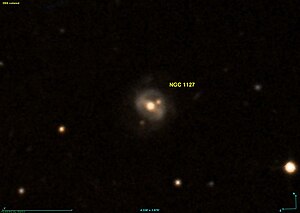NGC 1127
| Galaxy NGC 1127 |
|
|---|---|

|
|
| AladinLite | |
| Constellation | Aries |
|
Position equinox : J2000.0 , epoch : J2000.0 |
|
| Right ascension | 02 h 52 m 51.8 s |
| declination | + 13 ° 15 ′ 23 ″ |
| Appearance | |
| Morphological type | (R) SB (r) from: |
| Brightness (visual) | 14.7 mag |
| Brightness (B-band) | 15.5 mag |
| Angular expansion | 0.8 ′ × 0.8 ′ |
| Position angle | 39 ° |
| Surface brightness | 13.4 mag / arcmin² |
| Physical data | |
| Redshift | 0.032763 ± 0.000167 |
| Radial velocity | 9822 ± 50 km / s |
|
Stroke distance v rad / H 0 |
(441 ± 31) · 10 6 ly (135.1 ± 9.5) Mpc |
| diameter | 105,000 ly |
| history | |
| discovery | Albert Marth |
| Discovery date | December 2, 1863 |
| Catalog names | |
| NGC 1127 • UGC 2356 • PGC 10889 • CGCG 440-024 • MCG + 02-08-024 • 2MASX J02525187 + 1315231 • | |
NGC 1127 is a barred spiral galaxy of the Hubble type SBab in the constellation Aries on the ecliptic . It is estimated to be 441 million light years away from the Milky Way and has a diameter of around 90,000 ly.
In the same area of the sky are the galaxies NGC 1116 , NGC 1117 , NGC 1134 , IC 267 , among others .
The object was discovered by Albert Marth on December 2, 1863 .
